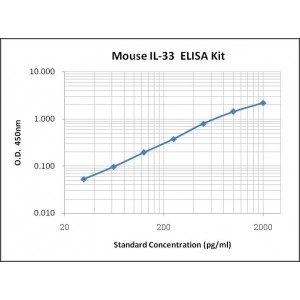More info
Assay Range | 31.2 - 2,000 pg/mL |
Sensitivity | 10.0 pg/mL |
Specificity | No cross-reaction with other related substances detected |
Size | 96T |
Storage | Store at 2 - 8ºC. Keep reconstituted standard and detection Ab at -20 ºC |
Assay Principle | Sandwich ELISA |
Sample Volume | 100 µL final volume, dilution factor varies on samples |
Sample Type | serum, plasma or cell culture supernatant |
Detection Method | Chromogenic |
Kit Components
1. Recombinant Mouse IL-33 standard: 2 vials
2. One 96-well plate coated with Mouse IL-33 Ab
3. Sample diluent buffer: 12 mL - 1
4. Detection antibody: 130 µL, dilution 1:100
5. Streptavidin-HRP: 130 µL, dilution 1:100
6. Antibody diluent buffer: 12 mL x1
7. Streptavidin-HRP diluent buffer: 12 mL x1
8. TMB developing agent: 10 mL x1
9. Stop solution: 10 mL x1
10. Washing solution (20x): 25 mL x1
Background
Interleukin-33 (IL-33), also known as interleukin-1 family member 11 (IL-1F11), nuclear factor from high endothelial venules (NF-HEV) and DVS, is a cytokine belonging to the IL-1 superfamily. Human IL-33 is synthesized as a 270 amino acid (aa) protein with an N-terminal nuclear localization signal, a helix-turn-helix motif, and a C-terminal domain homologous to IL-1 family. Cleavage of full length IL-33 leads to the extracellular release of a C-terminal fragment known as mature IL-33. Cathepsin G, Elastase, and Proteinase 3 can each cleave full length IL-33 to generate numbers of mature IL-33 with variable N-termini. Mature mouse IL-33 shares 57% and 90% aa sequence identity with human and rat IL-33, respectively.
IL-33 elicits its effects by binding the transmembrane receptor ST2/IL-1 R4 which subsequently interacts with IL-1 RacP, a common signaling subunit used by the receptors IL-1 RI, IL-1 RII, IL-1 R6, and SCF R/c-kit. IL-33 signaling through ST2 also triggers VE-Cadherin phosphorylation and internalization on vascular endothelial cells which leads to increased vascular permeability, vessel sprouting, and tubule formation. IL-33 exhibits multiple activities on immune system. It induces Th2 cells, basophils, and mast cells migration to sites of inflammation and production of Th2 cytokines. IL-33 plays a role in infection clearance by enhancing neutrophil sensitization to TLR and Dectin-1 signaling, phagocytic activity, and migration to sites of infection.


